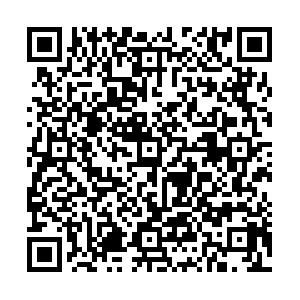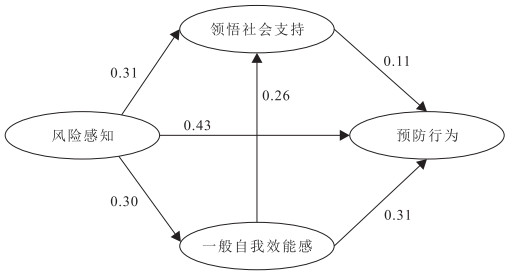Risk perception and behavior analysis of Guizhou college students on COVID-19 epidemic
-
摘要:
目的 探究新冠肺炎后疫情期大学生复课后的风险感知和预防行为,为学校疫情防控工作提供指导。 方法 采用方便取样法,抽取贵州某高校835名复课大学生,采用一般自我效能感问卷、领悟社会支持问卷和自行设计问卷进行调查。 结果 37.0%的大学生认为感染的概率很高,57.4%的大学生认为如果感染严重程度很高,大学生认为远离拥挤的场所是较好的预防行为(84.3%),89.7%的大学生常戴口罩,91.4%的大学生常洗手;一般自我效能感、领悟社会支持和预防行为两两间呈正相关(r=0.10~0.65,P值均 < 0.01);一般自我效能感和领悟社会支持在风险感知和预防行为间既起部分中介作用,也起链式中介作用。 结论 大学生对新型冠状病毒的风险感知中等,能采取积极的预防措施,风险感知可直接影响预防行为,也可通过领悟社会支持和一般自我效能感间接影响大学生的预防行为。 Abstract:Objective In order to provide guidance for the prevention and control of epidemic situations in schools, this paper explores the risk perception and prevention behaviors of college students after classes resume in the post-epidemic period of novel coronavirus pneumonia. Methods By using convenient sampling method, 835 college students who resumed classes were randomly selected from a university in Guizhou. Self-efficacy questionnaire, perceived social support questionnaire and self-designed questionnaire were adiministered. Results Totally 37.0% of college students believed that the risk of infection was high, 57.4% of college students believed the severity of infection was very high once get infected, meanwhile, 84.3% of them think that keeping away from crowded places was a better preventive behavior, 89.7% of college students often wear masks, 91.4% of college students wash their hands frequently. There was a significant positive correlation between general self-efficacy, perceived social support and preventive behavior (r=0.10-0.65, P < 0.01). General self-efficacy and perceived social support play both a partial intermediary role and a chain intermediary role between risk perception and preventive behavior. Conclusion Risk perception of Novel Coronavirus was moderate among college students, who can take active measures to effectively prevent it. Risk perception could not only directly affect the prevention behavior of college students, but also indirectly affect the prevention behavior of college students through understanding social support and general self-efficacy. -
Key words:
- Coronavirus /
- Risk management /
- Behavior /
- Health education /
- Students
-
表 1 贵州大学生COVID-19的风险感知预防行为信念频率分布(n=835)
Table 1. Distribution of risk perception and preventive behavior belief of COVID-19 in Guizhou college students (n=835)
变量 非常低 很低 不高不低 很高 非常高 感知风险 感知易感性 96(11.5) 157(18.8) 273(32.7) 213(25.5) 96(11.5) 感知严重性 39(4.7) 80(9.6) 237(28.4) 304(36.4) 175(21.0) 感知信息充分性 25(3.0) 15(1.8) 296(35.4) 374(44.8) 125(15.0) 感知信息收集能力 10(1.2) 10(1.2) 220(26.3) 350(41.9) 245(29.3) 复课后预防行为信念 戴口罩 16(1.9) 41(4.9) 175(21.0) 365(43.7) 238(28.5) 手卫生 20(2.4) 38(4.6) 150(18.0) 402(48.1) 225(26.9) 减少使用公共交通 17(2.0) 29(3.5) 142(17.0) 412(49.3) 235(28.1) 远离拥挤场所 19(2.3) 24(2.9) 88(10.5) 398(47.7) 306(36.6) 推迟/取消社交活动 16(1.9) 26(3.1) 109(13.1) 408(48.9) 276(33.1) 注:()内数字为构成比/%。 表 2 贵州大学生COVID-19的预防行为频率分布(n=835)
Table 2. Distribution of prevention behaviors of COVID-19 among college students in Guizhou (n=835)
预防行为 从不 有时 经常 总是 戴口罩 8(1.0) 78(9.3) 373(44.7) 376(45.0) 手卫生 3(0.4) 69(8.3) 414(49.6) 349(41.8) 减少使用公共交通 8(1.0) 67(8.0) 349(41.8) 411(49.2) 远离拥挤场所 5(0.6) 114(13.7) 381(45.6) 335(40.1) 推迟/取消社交活动 13(1.6) 101(12.1) 376(45.0) 345(41.3) 注:()内数字为构成比/%。 表 3 贵州大学生COVID-19的风险感知预防行为一般自我效能感领悟社会支持的相关系数(r值,n=835)
Table 3. Correlation coefficients of COVID-19's risk perception, preventive behavior, general self-efficacy and perceived social support (r, n=835)
变量 感知易感性 感知严重性 信息充分性 信息收集能力 戴口罩 手卫生 减少使用公共交通 远离拥挤场所 推迟/取消社交活动 自我效能感 感知严重性 0.45** 信息充分性 0.07* 0.10** 信息收集能力 0.05 0.11** 0.46** 戴口罩 0.01 0.07* 0.25** 0.35** 手卫生 0.02 0.08* 0.26** 0.32** 0.65** 减少使用公共交通 0.02 0.07 0.24** 0.32** 0.54** 0.59** 远离拥挤场所 0.03 0.04 0.25** 0.25** 0.55** 0.64** 0.65** 推迟/取消社交活动 0.02 0.02 0.23** 0.25** 0.52** 0.53** 0.63** 0.65** 自我效能感 -0.04 -0.04 0.28** 0.13** 0.21** 0.25** 0.18** 0.28** 0.24** 领悟社会支持 -0.05 0.02 0.29** 0.23** 0.23** 0.26** 0.24** 0.25** 0.24** 0.35** 注:*P < 0.05,**P < 0.01。 -
[1] BAO Y P, SUN Y K, MENG S Q, et al. 2019-nCoV epidemic: address mental health care to empower society[J]. Lancet, 2020, 395(10224): e37-e38. doi: 10.1016/S0140-6736(20)30309-3 [2] PAN X C, DAVID M O, GAO T Y, et al. Lessons learned from the 2019-nCoV epidemic on prevention of future infectious diseases[J]. Microbes Infect, 2020, 22(2): 86-91. doi: 10.1016/j.micinf.2020.02.004 [3] XIAO C. A novel approach of consultation on 2019 Novel Coronavirus (COVID-19)-Related psychological and mental problems: structured letter therapy[J]. Psychiatry Invest, 2020, 17(2): 175-176. doi: 10.30773/pi.2020.0047 [4] HUANG Y, ZHAO N. Generalized anxiety disorder, depressive symptoms and sleep quality during COVID-19 outbreak in China: a web-based cross-sectional survey[J]. Psychiatry Res, 2020, 288: 112954. DOI: 10.1016/j.psychres.2020.112954. [5] LEE M, YOU M. Psychological and behavioral responses in South Korea during the early stages of Coronavirus Disease 2019 (COVID-19)[J]. Int J Environ Res Public Health, 2020, 17(9): 2977. doi: 10.3390/ijerph17092977 [6] BREWER N T, WEINSTEIN N D, CUITE C L, et al. Risk perceptions and their relation to risk behavior[J]. Ann Behav Med, 2004, 27(2): 125. doi: 10.1207/s15324796abm2702_7 [7] MADDUX J E, ROGERS R W. Protection motivation and self-efficacy: a revised theory of fear appeals and attitude change[J]. J Exp Soc Psychol, 1983, 19(5): 469-479. doi: 10.1016/0022-1031(83)90023-9 [8] BRUG J, ARO ARJA R, OENEMA A, et al. SARS risk perception, knowledge, precautions, and information sources, the Netherlands[J]. Emerg Infect Dis, 2004, 10(8): 1486-1489. doi: 10.3201/eid1008.040283 [9] SADIQUE M Z, EDMUNDS W J, SMITH R D, et al. Precautionary behavior in response to perceived threat of pandemic influenza[J]. Emerg Infect Dis, 2007, 13(9): 1307-1313. doi: 10.3201/eid1309.070372 [10] JULIA E A, NICOLE L, JEFFREY W, et al. Non-pharmaceutical public health interventions for pandemic influenza: an evaluation of the evidence base[J]. BMC Public Health, 2007, 7(1): 208. doi: 10.1186/1471-2458-7-208 [11] ONNO DE Z, IRENE K V, JAN HENDRIK R, et al. Monitoring of risk perceptions and correlates of precautionary behaviour related to human avian influenza during 2006 - 2007 in the Netherlands: results of seven consecutive surveys[J]. BMC Infect Dis, 2010, 10(1): 114. doi: 10.1186/1471-2334-10-114 [12] FIELDING R, LAM W W T, HO E Y Y, et al. Avian influenza risk perception, Hong Kong[J]. Emerg Infect Dis, 2005, 11(5): 677-682. doi: 10.3201/eid1105.041225 [13] REBOK G W, BALCERAK L J. Memory self-efficacy and performance differences in young and old adults: the effect of mnemonic training[J]. Dev Psychol, 1989, 25(5): 714-721. doi: 10.1037/0012-1649.25.5.714 [14] 汪向东, 王希林, 马弘. 心理卫生评定量表手册: 增订版[M]. 北京: 中国心理卫生杂志社, 1993: 131-133.WANG X D, WANG X L, MA H. Rating Scales for Mental Health (Revised Edition)[M]. Beijing: Chinese Journal of Mental Health, 1999: 127-132. [15] 温忠麟, 叶宝娟. 有调节的中介模型检验方法: 竞争还是替补?[J]. 心理学报, 2014, 46(5): 714-726. https://www.cnki.com.cn/Article/CJFDTOTAL-XLXB201405013.htmWEN Z L, YE B J. Different methods for Testing moderated mediation models: competitors or backups?[J]. Acta Psychol Sinica, 2014, 46(5): 714-726. https://www.cnki.com.cn/Article/CJFDTOTAL-XLXB201405013.htm [16] ZOU X, CHEN K, ZOU J W, et al. Single-cell RNA-seq data analysis on the receptor ACE2 expression reveals the potential risk of different human organs vulnerable to 2019-nCoV infection[J]. Front Med, 2020, 14(4): 185-192. http://www.cqvip.com/QK/71235X/20202/7101855074.html [17] 张周炎, 李继朋, 熊永新. 从一街镇居家隔离状况探讨新型冠状病毒疫情的防控成效[J]. 按摩与康复医学, 2020, 11(11): 1-3. https://www.cnki.com.cn/Article/CJFDTOTAL-AMYD202011002.htmZHANG Z Y, LI J P, XIONG Y X. Discussion on the prevention and control effect of novel coronavirus epidemic from the situation of home isolation in a street town[J]. Chin Manipul Rehabil Med, 2020, 11(11): 1-3. https://www.cnki.com.cn/Article/CJFDTOTAL-AMYD202011002.htm [18] LUSZCZYNSKA A, CAO D S, MALLACH N, et al. Intentions, planning, and self-efficacy predict physical activity in Chinese and Polish adolescents: two moderated mediation analyses[J]. Int J Clin Health Psychol, 2010, 10(2): 265-278. http://psycnet.apa.org/record/2010-07740-004 [19] YUE C Y, LIU C P, WANG J, et al. Association between social support and anxiety among pregnant women in the third trimester during the coronavirus disease 2019 (COVID-19) epidemic in Qingdao, China: the mediating effect of risk perception[J]. Int J Soc Psychiatry, 2020. DOI: 10.1177/0020764020941567. [20] CUMMINGS C L, ROSENTHAL S, KONG W Y. Secondary risk theory: validation of a novel model of protection motivation[J]. Risk Anal, 2020(1). DOI: 10.1111/visa.13573. [21] BANDURA A, FREEMAN W H, LIGHTSEY R. Self-efficacy: the exercise of control[J]. J Cogn Psychother, 1997, 13(2): 158-166. http://psycnet.apa.org/psycinfo/1997-08589-000 [22] HAN K M, PARK J Y, PARK H E, et al. Social support moderates association between posttraumatic growth and trauma-related psychopathologies among victims of the Sewol Ferry Disaster[J]. Psychiatry Res, 2019, 272: 507-514. DOI: 10.1016/j.psychres.2018.12.168. -







 下载:
下载:

